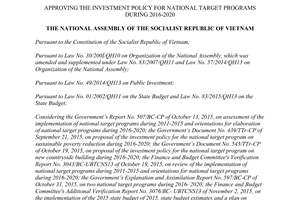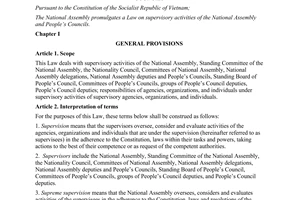Nội dung toàn văn Resolution 32/2016/QH14 further raising building new countryside
|
THE
NATIONAL ASSEMBLY |
THE
SOCIALIST REPUBLIC OF VIETNAM |
|
No. 32/2016/QH14 |
Hanoi, November 23, 2016 |
RESOLUTION
ON FURTHER RAISING EFFECT AND THE EFFECTIVENESS OF IMPLEMENTATION OF THE NATIONAL TARGET PROGRAM ON BUILDING A NEW COUNTRYSIDE ASSOCIATED WITH AGRICULTURAL RESTRUCTURING
THE NATIONAL ASSEMBLY OF
THE SOCIALIST REPUBLIC OF VIETNAM
Pursuant to the Constitution of the Socialist Republic of Vietnam;
Pursuant to Law No. 87/2015/QH13 on Oversight Activities of the National Assembly and People’s Councils;
Pursuant to the National Assembly’s Resolution No. 91/2015/QH13 of June 18, 2015, on the National Assembly’s Oversight Activity Program in 2016;
On the basis of considering the National Assembly Standing Committee’s Report No. 44/BC-UBTVQH14 of October 31, 2016, on oversight results of implementation of the national target program on building a new countryside associated with agricultural restructuring, and Report No. 67/BC-UBTVQH14 of November 22, 2016, on assimilation of and response to opinions of National Assembly deputies;
RESOLVES:
Article 1.
The National Assembly agreed with the National Assembly Standing Committee’s oversight report on achievements, limitations, problems and causes of the promulgation of policies and laws and organization of implementation of the national target program on building a new countryside (below referred to as Program) in the 2010-2015 period, associated with agricultural restructuring, and recommendations and proposals:
Over five years of implementing the Program, rural areas have recorded positive changes, especially technical infrastructure systems; concentrated production models have initially been formed; people’s incomes have increased and their material and spiritual lives have improved; and the awareness of officials and people about building a new countryside has been raised. Building a new countryside has become a nationwide movement.
However, there remained limitations and problems in implementing the Program such as slow, incomplete and unsynchronous promulgation of guiding documents, a number of criteria in the national criteria of new countryside unsuitable with practical conditions and characteristics of each region, area and locality, and planning work still having shortcomings and poor quality. Results of building a new countryside were uneven with wide gaps among localities, areas and regions. A number of localities have paid too much attention to infrastructure investment but undue attention to people’s cultural and spiritual lives, production development and people’s income raising. People have been mobilized to make contributions higher than their incomes in some localities. Economic and agricultural restructuring has remained slow and not been associated with building a new countryside, sustainable poverty reduction and response to climate change. Rural economic restructuring has not recorded great changes with limitations in the development of cooperative models under the Law on Cooperatives and in models of enterprise joint venture, partnership and attraction; connection between industry and service and agricultural production remained lax and unsustainable; incentive policies and mechanisms for land accumulation to create concentrated commodity production models were not strong and clear enough; limitations remained in linkages between production, processing and sale of agricultural products and scientific and technological application to agricultural production, agricultural products with national brands and high added value have not been created. State budget funds for investment have failed to meet demands, outstanding capital construction debts remained in a number of localities and rural environmental pollution has posed many challenges. People’s mastery role in many places has not been fully promoted.
Apart from differences in natural conditions and uneven development between regions and areas, the above limitations and problems were caused by lax coordination between ministries and sectors, limited capacity and awareness in directing and organizing implementation of a number of officials, especially at the grassroots level, as well as ministries’ and sectors’ delays in promulgating guiding documents, consequently affecting effect and effectiveness of the Program implementation, and a number of localities’ and establishments’ failure to strictly observe the law on public investment, causing outstanding capital construction debts.
Article 2.
To raise the effect and effectiveness of the Program in the next period, aiming to have around 50% of the communes nationwide reaching new-countryside standards, the National Assembly requests the Government to effectively implement the National Assembly’s Resolution No. 100/2015/QH13 of November 12, 2015, approving the investment policy for national target programs in the 2016-2020 period and to focus on the following major tasks and solutions:
1. To study and revise inappropriate criteria of the national set of norms for building a new countryside for 2016-2020. To set high norms for communes having reached new- countryside standards. To promptly and synchronously promulgate documents guiding the Program implementation; to review, adjust and supplement inappropriate master plans.
2. To instruct ministries, sectors and localities to review and accurately determine the Program’s outstanding capital construction debts, formulate plans and roadmaps for settlement before 2019, and make sure no outstanding capital construction debts arise. In particular, localities with budget self-balancing (except for Quang Ngai province under the National Assembly’s Resolution No. 100/2015/QH13 of November 12,2015, approving the investment policy for national target programs in the 2016-2020 period) shall proactively allocate local budget funds to basically settle outstanding debts before June 2018.
To review and clearly identify responsibilities and strictly handle organizations and their heads that mobilize people’s contributions beyond their capacity, report outstanding capital construction debts in contravention of regulations or commit corrupt or self-interest acts in the Program implementation.
3. In the Program implementation, to attach importance to boosting production and renewing production structure in close association with agricultural restructuring, response to climate change, environmental protection and sustainable development. By 2020, to raise the per-capita income in rural areas nationwide by at least 1.8 folds over the 2015’s figure, to basically complete essential works to meet the demands of production development and people’s life such as transport, electricity, residential water, schools, clinics and environment sanitation.
To develop incentive mechanisms and policies to create favorable environment for the development of agricultural cooperatives; by 2020, to have 15,000 agricultural cooperatives and unions of agricultural cooperatives operating effectively, to promote and multiply effective models of joint venture and partnership in agricultural production.
4. To study and revise land policies to encourage land accumulation and mechanize to promote large-scale commodity production; to develop breakthrough policies in science and technology to increase labor productivity and competitiveness of agricultural products; to create a favorable environment and provide further support to attract enterprises’ investment in rural development, especially agricultural start-ups; to enhance linkage among farmers, the State, entrepreneurs and scientists in agricultural production to create a chain from production to processing and sale; to increase international competitiveness and economic integration toward an organic, quality and high-value agriculture. To effectively restructure rural labor, by 2020, to strive to cut the rate of agricultural labor to under 40% of the total social workforce and improve effectiveness of vocational training programs for rural laborers.
5. To effectively combine funding sources, prioritizing investment in developing production models, raising incomes and generating jobs; to closely combine the Program with the national target program on sustainable poverty reduction and other target programs. To synchronously implement solutions to adequately and promptly mobilize capital according to proper structure. Apart from capital sources allocated by the National Assembly, to mobilize more legitimate resources. Localities shall sufficiently allocate local budget funds in accordance with law for the Program implementation. To prioritize budget-funded sources for specially disadvantaged communes, sandbank communes in coastal and island areas, poor communes, and communes in safety zones, revolutionary bases, and ethnic minority and mountainous areas.
6. To promulgate policies on insurance attached to reinsurance of agricultural products applicable to essential agricultural products.
7. To consolidate and strengthen the political system, to raise awareness of Party committees at all levels and commune-level administrations and the quality of personnel in charge of countryside building work toward professionalism and full-time job without increasing the payroll; to increasingly train and develop a contingent of village officials to work in new countryside building. To boost retraining to improve managerial capacity and skills to implement, formulate and organize the implementation of master plans and plans, and organize the implementation of community-managed projects, and finance and accounting for hamlet and commune officials implementing projects under the Program.
8. To increase public information to create changes in awareness and acts of economic sectors and people of all strata. To regularly update and cover in the mass media good methods, effective models and exemplary models of building a new countryside. To timely encourage and commend exemplary units and individuals in the movement of building a new countryside.
9. To firmly maintain political security, social order and safety in rural areas and concurrently adopt measures to reduce negative practices and social evils and traffic accidents, ensure food safety and hygiene and improve people’s health in socio-economic development and rural urbanization; to timely and effectively settle conflicts and disputes in residential areas, contributing to building a cultural life of unity, democracy and civilization; to preserve and uphold fine traditional cultural values and preserve national cultural identities of regions. To quickly adopt positive solutions to basically handle environmental pollution in rural areas and craft villages so as to create a green, clean and beautiful landscape and environment in rural areas and improve people’s living conditions.
10. To enhance inspection, examination, auditing and supervision and strictly handle violations by organizations and individuals in implementing the Program. To further bring into play the oversight and social criticism role of the Vietnam Fatherland Front and its member organizations and residential communities in building a new countryside. To complete mechanisms for residential communities to directly implement and supervise investment projects to improve their quality.
Article 3.
To assign the Government and local administrations at all levels to, within the ambit of their tasks and powers, organize the implementation of this Resolution.
Annually, the Government shall report to the National Assembly on the results of implementation of this Resolution together with the results of implementation of the national target program under the National Assembly’s Resolution No. 100/2015/QH13 of November 12,2015.
Article 4.
The Standing Committee of the National Assembly, the Ethnic Council and National Assembly Committees, National Assembly deputies’ delegations and National Assembly deputies, the Vietnam Fatherland Front and its member organizations shall, according to their functions, tasks and powers, oversee the implementation of this Resolution.
This Resolution was passed on November 23, 2016, by the XIVth National Assembly of the Socialist Republic of Vietnam at its second session.-
|
|
CHAIRWOMAN
OF THE NATIONAL ASSEMBLY |




